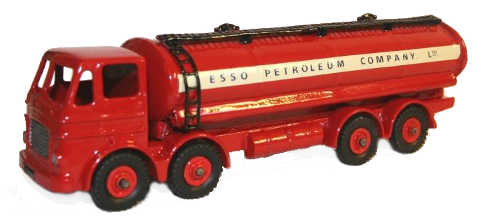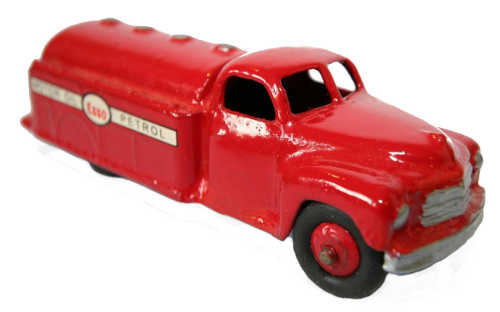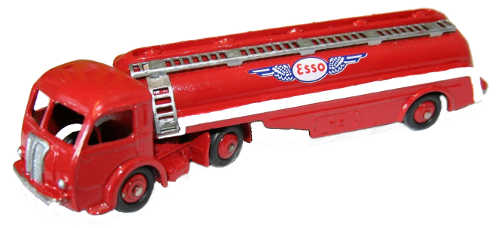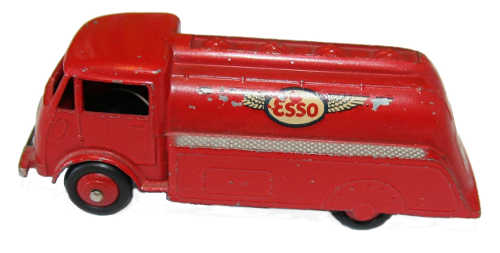Dinky Toys: the Esso tankers

Esso began life as the Anglo American Oil Company in 1888. By 1911, it was part of the US Company, Standard Oil, which had its UK head office in London, and a depot at Purfleet in Essex. The depot stored paraffin being shipped from New York for use in lamps. In 1934, the UK part of the company took a phonetic version of the initials of Standard Oil (SO = Esso) for some of its brand names. In 1951, Esso was adopted as the company name. Because use of the Esso trademark in the US was restricted, Standard Oil (New Jersey) chose Exxon as its name in 1972.
The Dinky UK Leyland Octopus Esso Tanker (943) was released in March 1958 and was advertised inside the back cover of that month’s Meccano Magazine for 11/6. At 7 and 5/8 inches long, later versions were fitted with plastic windows. The Esso tanker used the same body as the earlier Fodens, which were produced from 1948-64. Advertised in the August 1958 Meccano Magazine for 10/9. The model was released in 1958 and withdrawn in 1964.

In reality, Leyland created the Octopus when they added a second steering axle to a 6 wheeler Hippo. Manufacture of the 22 ton, 8 wheeled vehicle, took place from 1935-79 with a major up-date in 1960. The 1950s model was one of the most popular and successful heavy trucks of its time.
The Dinky, Studebaker, Esso Petrol Tanker (442) had an original price of 10/6. Renumbered from 30p in 1954, the proposed model was to be produced with an aluminium body at a 1:60 scale and be available in a red and black finish. The Studebaker replaced the outdated 1930s model 25d, was released in 1954 and withdrawn in 1960.

The tanker was based on the Studebaker 2.5 ton truck, which, in reality, also appeared as a fire engine, in Neshanic, New Jersey, and as an open-topped, canopy covered tour-bus for Handford, California. The Dinky Toy model appeared in the livery of several different oil companies, ‘Mobilgas’ (440), ‘Castrol’ (441) and ‘National Benzole’ (443). Dinky withdrew the model in 1960.
The third model in the French Dinky series numbered 32 the articulated Esso Tanker (32C) was based on a Panhard Movic tractor unit and Titan tanker. The model was released in September 1954, was 178mm long and was only available in a red finish, with a white band along the tank. There are, however, 4 variants of the model, which can be distinguished by the size and colour of the decals, the painting of the rear bumper and the type of tyres fitted; the latter version having treaded tyres. The rarity is to have a model with a black galvanised scale. An original cost of 5785 francs is often quoted for this model. The tanker was withdrawn in 1963.


The French Dinky Ford Esso Tanker 25 U had original cost of 180 francs. At 1:65 scale, the Ford tanker was 105mm long. Released in 1950, the model was withdrawn in 1953.
Built at Poissy, on the south-western outskirts of Paris, this Ford truck of pre-war design was manufactured in the late 1940s following the liberation of France. The truck was introduced as a Matford in the late 1930s, but by 1940 the Mathis/Ford (i.e. Matford) partnership had run into difficulties and amid much litigation, the post-war French built Matford trucks were badged as Fords.
In November 1948, Dinky Toys France presented its new 25 series starting from a cab truck. It was used to differentiate this series from pre-war models. French Dinky Toys used capital letters (25A, 25B, 25C ...). The Ford trucks were in 3 groups: the chassis long referenced with the letters H, I, J and K; the frame with monocoque frame V and the vehicles with a shorter chassis, M, O or U.
Thanks to John Morris for the article on this page.